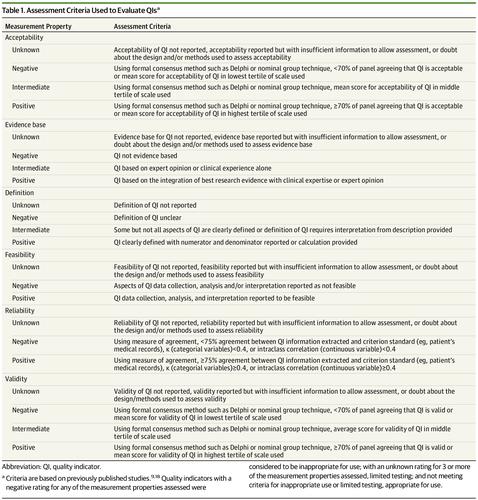JAMA Oncology ( IF 22.5 ) Pub Date : 2020-01-01 , DOI: 10.1001/jamaoncol.2019.3388 Lesley Anne Henson 1 , Polly Edmonds 2 , Anna Johnston 1 , Halle Elizabeth Johnson 1 , Clarissa Ng Yin Ling 3 , Alexandros Sklavounos 3 , Clare Ellis-Smith 1 , Wei Gao 1

|
Importance Improving the quality of cancer care is an international priority. Population-based quality indicators (QIs) are key to this process yet remain almost exclusively used for evaluating care during the early, often curative, stages of disease.
Objectives To identify all existing QIs for the care of patients with cancer who have advanced disease and/or are at the end of life and to evaluate each indicator’s measurement properties and appropriateness for use.
Evidence Review For this systematic review, 5 electronic databases (MEDLINE, Embase, CINAHL, PsycINFO, and the Cochrane Library) were searched from inception through February 4, 2019, for studies describing the development, review, and/or testing of QIs for the care of patients with cancer who have advanced disease and/or are at the end of life. For each QI identified, descriptive information was extracted and 6 measurement properties (acceptability, evidence base, definition, feasibility, reliability, and validity) were assessed using previously established criteria, with 4 possible ratings: positive, intermediate, negative, and unknown. Ratings were collated and each QI classified as appropriate for use, inappropriate for use, or of limited testing. Among the QIs determined as appropriate for use, a recommended shortlist was generated by excluding those that were specific to patient subgroups and/or care settings; related QIs were identified, and the indicator with the highest rating was retained.
Findings The search yielded 7231 references, 35 of which (from 28 individual studies) met the eligibility criteria. Of 288 QIs extracted (260 unique), 103 (35.8%) evaluated physical aspects of care and 109 (37.8%) evaluated processes of care. Quality indicators relevant to psychosocial (18 [6.3%]) or spiritual and cultural (3 [1.0%]) care domains were limited. Eighty QIs (27.8%) were determined to be appropriate for use, 116 (40.3%) inappropriate for use, and 92 (31.9%) of limited testing. The measurement properties with the fewest positive assessments were acceptability (38 [13.2%]) and validity (63 [21.9%]). Benchmarking data were reported for only 16 QIs (5.6%). The final 15 recommended QIs came from 6 studies.
Conclusions and Relevance The findings suggest that only a small proportion of QIs developed for the care of patients with cancer who have advanced disease and/or are at the end of life have received adequate testing and/or are appropriate for use. Further testing may be needed, as is research to establish benchmarking data and to expand QIs relevant to psychosocial, cultural, and spiritual care domains.
中文翻译:

基于人群的临终癌症护理质量指标:系统评价
重要性 提高癌症治疗的质量是国际优先事项。基于人群的质量指标 (QIs) 是这一过程的关键,但仍然几乎专门用于评估疾病早期(通常是治愈性)阶段的护理。
目的 确定所有现有的 QI 用于治疗晚期疾病和/或处于生命末期的癌症患者,并评估每个指标的测量特性和适用性。
证据审查 在本次系统评价中,检索了 5 个电子数据库(MEDLINE、Embase、CINAHL、PsycINFO 和 Cochrane Library),从开始到 2019 年 2 月 4 日,用于描述 QIs 的开发、审查和/或测试的研究患有晚期疾病和/或生命即将结束的癌症患者。对于确定的每个 QI,提取描述性信息并使用先前建立的标准评估 6 个测量属性(可接受性、证据基础、定义、可行性、可靠性和有效性),并有 4 个可能的评级:正面、中间、负面和未知。对评级进行了整理,并将每个 QI 分类为适合使用、不适合使用或有限测试。在确定适合使用的 QI 中,通过排除特定于患者亚组和/或护理环境的那些,生成了推荐的候选名单;识别出相关 QI,保留评分最高的指标。
结果 搜索产生了 7231 篇参考文献,其中 35 篇(来自 28 项独立研究)符合资格标准。在提取的 288 个 QI(260 个独特的)中,103 个(35.8%)评估了护理的物理方面,109 个(37.8%)评估了护理过程。与社会心理 (18 [6.3%]) 或精神和文化 (3 [1.0%]) 护理领域相关的质量指标有限。80 个 QI (27.8%) 被确定为适合使用,116 个 (40.3%) 不适合使用,92 个 (31.9%) 被限制测试。正面评价最少的测量属性是可接受性(38 [13.2%])和有效性(63 [21.9%])。仅报告了 16 个 QI (5.6%) 的基准数据。最后推荐的 15 个 QI 来自 6 项研究。
结论和相关性 研究结果表明,只有一小部分为治疗晚期疾病和/或生命末期的癌症患者而开发的 QIs 已经接受了充分的测试和/或适合使用。可能需要进一步的测试,以及建立基准数据和扩展与心理社会、文化和精神护理领域相关的 QI 的研究。









































 京公网安备 11010802027423号
京公网安备 11010802027423号